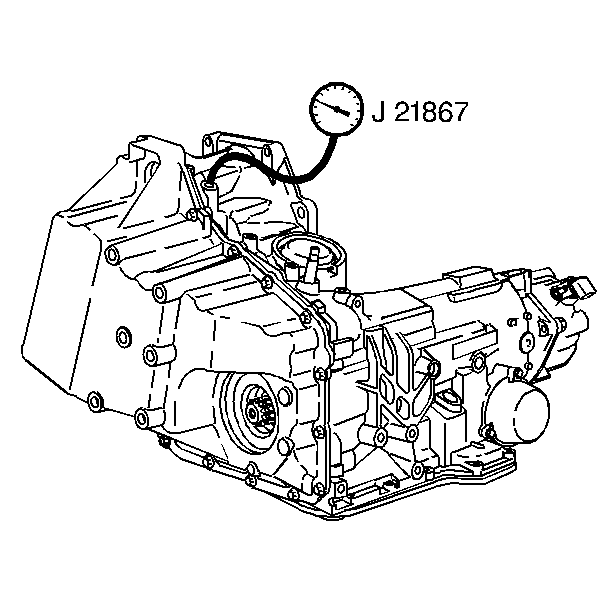Tools Required
| • | J 21867 Pressure Gage |
| • | J-21867-65 Pressure Test Adapter |
- Install a scan tool.
- Start the engine and set the parking brake.
- Check for a stored Diagnostic Trouble Code (DTC).
- Repair the vehicle, if necessary.
- Check the fluid level. Refer to the Transmission Fluid Check .
- Check the manual linkage for proper adjustment.
- Turn the engine Off.
- Loosen Exhaust cross-over pipe to allow attachment of J-21867-65 adapter.
- Remove the oil pressure test hole plug and install the J 21867 and J-21867-65 adapter.
- Put the gear selector in PARK range and set the parking brake.
- Start the engine and allow the engine to warm up at idle.
- Access the PC solenoid valve control test on the scan tool.
- Increase the PC solenoid actual current from 0 to 1 amps in 0.1 amp increments. Allow the pressure to stabilize for five seconds after each pressure change. Read the corresponding line pressure on the J 21867 .
- Refer to the Line Pressure specification table. Compare the data to the table.
- If pressure readings differ greatly from the table, refer to Incorrect Line Pressure .
- Shut the engine OFF. Remove the J 21867 and J-21867-65 .
- Apply sealant GM P/N 12345382 (Canadian P/N 1095348) to the oil pressure test hole plug.
- Install the oil pressure test hole plug.
- Re-tighten the exhaust cross-over pipe.
Important:
• Before performing a line pressure check, verify that the pressure control (PC) solenoid valve is receiving the correct electrical signal from the PCM. • Some conditions may be intermittent, therefore this test should be performed at least 3 times.
Caution: Keep the brakes applied at all times in order to prevent unexpected vehicle motion. Personal injury may result if the vehicle moves unexpectedly.

Notice: The total test running time should not be longer than 2 minutes. Running the test longer than 2 minutes may damage the transaxle.
Notice: Use the correct fastener in the correct location. Replacement fasteners must be the correct part number for that application. Fasteners requiring replacement or fasteners requiring the use of thread locking compound or sealant are identified in the service procedure. Do not use paints, lubricants, or corrosion inhibitors on fasteners or fastener joint surfaces unless specified. These coatings affect fastener torque and joint clamping force and may damage the fastener. Use the correct tightening sequence and specifications when installing fasteners in order to avoid damage to parts and systems.
Tighten
Tighten the plug to 12 N·m (106 lb in).
